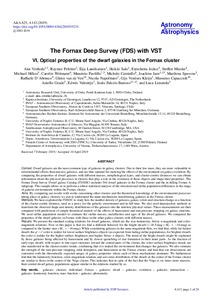The Fornax Deep Survey (FDS) with VST VI. Optical properties of the dwarf galaxies in the Fornax cluster
Aniello Grado; Raaele D’Abrusco; Gijs Verdoes Kleijn; Aku Venhola; Marilena Spavone; Michele Cantiello; Edwin Valentijn; Glenn van de Ven; Massimo Capaccioli; Michael Hilker; Heikki Salo; Joachim Janz; Luca Limatola; Enrichetta Iodice; Eija Laurikainen; Maurizio Paolillo; Steen Mieske; Carolin Wittmann; Jesús Falcón-Barroso; Nicola Napolitano; Reynier Peletier
The Fornax Deep Survey (FDS) with VST VI. Optical properties of the dwarf galaxies in the Fornax cluster
Aniello Grado
Raaele D’Abrusco
Gijs Verdoes Kleijn
Aku Venhola
Marilena Spavone
Michele Cantiello
Edwin Valentijn
Glenn van de Ven
Massimo Capaccioli
Michael Hilker
Heikki Salo
Joachim Janz
Luca Limatola
Enrichetta Iodice
Eija Laurikainen
Maurizio Paolillo
Steen Mieske
Carolin Wittmann
Jesús Falcón-Barroso
Nicola Napolitano
Reynier Peletier
EDP SCIENCES S A
Julkaisun pysyvä osoite on:
https://urn.fi/URN:NBN:fi-fe2021042826620
https://urn.fi/URN:NBN:fi-fe2021042826620
Tiivistelmä
Context. Dwarf galaxies are the most common type of galaxies in galaxy clusters. Due to their low mass, they are more vulnerable to environmental effects than massive galaxies, and are thus optimal for studying the effects of the environment on galaxy evolution. By comparing the properties of dwarf galaxies with different masses, morphological types, and cluster-centric distances we can obtain information about the physical processes in clusters that play a role in the evolution of these objects and shape their properties. The Fornax Deep Survey Dwarf galaxy Catalog (FDSDC) includes 564 dwarf galaxies in the Fornax cluster and the in-falling Fornax A subgroup. This sample allows us to perform a robust statistical analysis of the structural and stellar population differences in the range of galactic environments within the Fornax cluster.Aims. By comparing our results with works concerning other clusters and the theoretical knowledge of the environmental processes taking place in galaxy clusters, we aim to understand the main mechanisms transforming galaxies in the Fornax cluster.Methods. We have exploited the FDSDC to study how the number density of galaxies, galaxy colors and structure change as a function of the cluster-centric distance, used as a proxy for the galactic environment and in-fall time. We also used deprojection methods to transform the observed shape and density distributions of the galaxies into the intrinsic physical values. These measurements are then compared with predictions of simple theoretical models of the effects of harassment and ram pressure stripping on galaxy structure. We used stellar population models to estimate the stellar masses, metallicities and ages of the dwarf galaxies. We compared the properties of the dwarf galaxies in Fornax with those in the other galaxy clusters with different masses.Results. We present the standard scaling relations for dwarf galaxies, which are the size-luminosity, Sersic n-magnitude and color-magnitude relations. New in this paper is that we find a different behavior for the bright dwarfs (18.5 mag < M-r' < -16 mag) as compared to the fainter ones (M-r' > -16 mag): While considering galaxies in the same magnitude-bins, we find that, while for fainter dwarfs the g' - r' color is redder for lower surface brightness objects (as expected from fading stellar populations), for brighter dwarfs the color is redder for the higher surface brightness and higher Sersic n objects. The trend of the bright dwarfs might be explained by those galaxies being affected by harassment and by slower quenching of star formation in their inner parts. As the fraction of early-type dwarfs with respect to late-types increases toward the central parts of the cluster, the color-surface brightness trends are also manifested in the cluster-centric trends, confirming that it is indeed the environment that changes the galaxies. We also estimate the strength of the ram-pressure stripping, tidal disruption, and harassment in the Fornax cluster, and find that our observations are consistent with the theoretically expected ranges of galaxy properties where each of those mechanisms dominate. We furthermore find that the luminosity function, color-magnitude relation, and axis-ratio distribution of the dwarfs in the center of the Fornax cluster are similar to those in the center of the Virgo cluster. This indicates that in spite of the fact that the Virgo is six times more massive, their central dwarf galaxy populations appear similar in the relations studied by us.
Kokoelmat
- Rinnakkaistallenteet [19207]
